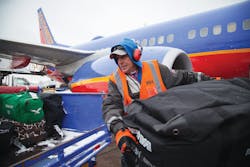Can the turns at Southwest Airlines get any better?
Evidently so since the airline that built its business on how quickly its ramp agents can get a plane at the gate airborne again announced a deal last month with PASSUR Aerospace, Inc to use the data management company’s integrated traffic management systems at 35 U.S. airports to, in part, streamline turn times, but also reduce fuel burn and enhance on-time performance.
The PASSUR Surface Management solution assists Southwest in achieving shorter taxi-in and taxi-out times, and a quicker transition from arrival to departure for an aircraft, resulting in lower costs and emissions from engine fuel burn, less time for passengers spent on the ground in the aircraft, and greater “aircraft utilization.”
The surface solution is part of an integrated, gate-to-gate traffic management platform that optimizes the entire lifecycle of a flight.
"We're doing everything we can to enhance the customer experience while reducing costs, and this contract falls right in line with that strategy," says Dave Wotton, director of automation and support for the airline’s operations coordination center.
IT INVESTMENTS
The Southwest deal is just a recent example of how airlines as well as airports are boosting their investments in IT to better serve their customers better, according to two annual SITA surveys both of which were released last year.
All the airlines surveyed planned to invest in what SITA labels “business intelligence solutions,” or BI, which will provide real-time information to know more about their customers and make better decisions throughout their operations.
The need for investment in BI is apparent since only 9 percent of the airlines currently rate data quality as meeting all their requirements, while just 7 percent have achieved the necessary integration of different data sources from across their company.
“All airlines are investing in business intelligence to improve their operations and boost revenues,” said Francesco Violante, CEO of SITA when the airline survey was released last June. “We see a strong desire to increase revenues using techniques borrowed from the retail industry, including personalization. Nearly three-quarters of airlines rate business intelligence for sales and marketing as a high priority. The airlines’ investment plans show the future of the industry is smarter, more mobile and more personal.”
Meanwhile, nearly 90 percent of the airports surveyed, for example, expect their IT spending to increase or remain stable. Either way, those plans say even more considering that over the past three years the compound annual growth rate in IT was 12 percent which far outpaced the growth in revenue itself, which stands at 3 percent.
There’s a growing importance just as on business intelligence for airports, too, based on the airport IT survey that came out last November. About 80 percent of the airports surveyed said they were planning to invest in new BI solutions for both revenue optimization and management by 2016.
Priorities for BI investment include airport operation, passenger flow monitoring and airport resource management. However, the survey points out that, like the airlines, the airports are far from where they hope to be with only 8 percent of the airports surveyed saying they’ve fully achieved the data quality requirements for their current BI initiatives.
Violante’s prepared requirements included with airport survey mirror much of the same sentiments as those he expressed for the airline survey.
“Our survey this year clearly shows that passengers are at the heart of this investment,” he stated. “As passenger traffic grows and airports aim to improve the passenger experience, technology is providing essential solutions, despite fluctuations in airport revenue.”
BAGGAGE SOLUTIONS
While much of the IT presence of either an airline or airport is readily apparent from, say, a website, a check-in app or onsite kiosks, there is an increasing effort to differentiate passenger services with a new array of mobile functionality that goes behind the scenes and onto the ramp.
The result will be a much deeper integration of personalized mobile service at every step of the journey for passengers on the move.
On the airline side, the SITA survey reveals a rapidly growing adoption of mobile solutions not just for passenger services, but also for the airline workforce. While the initial focus continues to be on improving productivity in the aircraft from moving from paper to digital, over the next three years around eight out of 10 airlines plan to provide flight crews with electronic flight bags and automate crew services.
However, the next “wave of services using tablets for the airline workforce will focus on airport operations such as ground operations … Up to now they have been a lower priority, with only a few airlines implementing tablets in these areas, but over the next three years that will jump to more the 70 percent of airlines," according to the survey.
And over on the airport side, the combination of big data and complex algorithms are opening the door to a more sophisticated use of BI.
Over the next three years, the survey says the focus of BI investments will shift to passenger flow monitoring and asset tracking designed to improve the use of resources at airports.
By the end of 2016, three-quarters of airports will be making some investment in these areas.
“In particular, monitoring passenger flow can ensure people move through the airport at an optimum rate to minimize delay,” the survey states.
BAGGAGE REPORT
To understand how these IT investments will affect ramp work, it helps to take a look at one other SITA survey. The group’s ninth annual Baggage Report, released last May, showed a continued improvement in the baggage mishandling rates.
- Mishandled bags rate dropped to 8.83 bags per 1,000 passengers, a drop of 44.5 percent in the number of mishandled bags in the past six years.
- Given the nearly 3 billion enplaned passengers, that means that for every 100 passenger less than one bag was reported as mishandled.
- Industry-wide, the mishandled bag rate decrease has saved the industry more than $2 billion in 2012.
- Delayed baggage, responsible for eight out of 10 mishaps, fell 2.4 percent.
Chances are those mishaps center on the transfer between flights.
“Handling of transfer bags remains the pinch point in the baggage handling process,” the report states. “Not only does increasing air traffic place greater stress on bag operations, delays and unexpected changes to schedules can quickly have a negative impact on transfer bags. Despite the year’s rise in passenger traffic, transfer bags accounted for 48 percent of all delayed bags, down from 53 percent in 2011.”
The report highlights a few cases of effective collaboration to address how airlines and airports taking effective control of transfers bags.
Iberia Airlines: The airline’s “Agora” project is speeding up the transfer bag process by giving priority to one type of passenger over another, depending on real-time needs. At Madrid Airport, for example, that means sending non-priority baggage in low speed belts, while tight connections are processed on the fastest belts – which can be 8 minutes faster sending bags from the main terminal to a satellite terminal.
“There are no more fixed rules for all flights,” says Rodrigo Genta, Iberia’s baggage handling manager. “Standardization is great under some circumstances, but we need to be flexible in our operation and do what is best for the customer whenever possible.”
The airline has driven down the mishandling rate at its Madrid hub by 40 percent since 2009. And since the Agora project officially began in 2011, the mishandling rate has dropped 12 percentage points.
Helsinki Airport: A new baggage handling system that went online last March was designed to achieve a transfer time of just 30 minutes. A transfer monitoring tool gives automatic notifications of delays of incoming flights that are carrying transfer baggage and allows the airport to implement special measures to ensure that the bags reach their connecting flight even when time is tight.
Esa Siponen, vice president of Helsinki Airport, says passengers totals of 15 million in 2011 helped solidify the airport’s position as the leading long-haul airport for Northern Europe.
“The new baggage handling system will provide a foundation on which the airport can achieve continued growth by ensuring high terminal efficiency and ultra-fast connection time, which will make a significant contribution to the overall passenger experience,” Siponen says.
Bangalore Airport: The airport reviews baggage delivery data with its airlines and ground handlers. Last year, the airport introduces a mobile solution to capture data from the time the aircraft lands to its turn and departure to enhance on-time performance of flights.
Last April, secured Wi-Fi enabled ground handlers to scan bags before loading, reconciling bags at the final stages of the flight. One month later, ground handlers began using a mobile-based solution to track baggage processes in real time to better meet performance targets.
“The intent is to pro-actively intervene and reallocate resources if there is a deviation to standards,” says Francis Rajan, the airport’s vice president.
London Heathrow Airport: The airport is currently in the process of creating a “bag factory,” an integrated baggage hub that will continue over the five years. A fundamental process is batch building, which relies on the logistics of empty baggage carts moved into the bag factory using “just-in-time” methodology more commonly used in manufacturing processes.
Along with greater efficiency and accuracy, the bag factory will reduce the time take to process transfer baggage and cut down on the time baggage handlers spend driving bags around the airport.
“Working in collaboration with the airlines and ground handlers,” says John Beasley, head of the airport’s baggage strategy, “we will be able to tailor the daily operational plans much more precisely to the expected demand as we use the facility to manage the flow of bags to the ground handlers in pre-segregated batches.”
Looking forward, SITA’s Baggage Report concludes that there will be “no let-up in pressure” on baggage handling operations.
“Passenger numbers continue to grow, even in these times of reduced economic activity,” the report states. “There will also be no let-up in industry efforts to reduce the mishandling rates.”
Additional new technologies and systems outlined in the report promise to reduce the mishandling rate to 4.5 mishandled bags per 1,000 passengers.
“It is a figure that is nearly half of where we are today, so there is still much work to do,” the reports adds.



